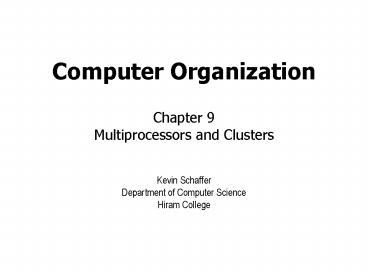Chapter 9 Multiprocessors and Clusters - PowerPoint PPT Presentation
1 / 22
Title:
Chapter 9 Multiprocessors and Clusters
Description:
Processors share a single address space ... UMA vs. NUMA ... Non-uniform memory access (NUMA): some memory accesses are faster than others ... – PowerPoint PPT presentation
Number of Views:154
Avg rating:3.0/5.0
Title: Chapter 9 Multiprocessors and Clusters
1
Chapter 9Multiprocessors and Clusters
Computer Organization
- Kevin Schaffer
- Department of Computer Science
- Hiram College
2
Multiprocessors
- Two or more processors that work together as a
single computer system - Why?
- Performance (throughput)
- Memory
- Redundancy
3
Design Issues
- Number/type of processors
- Memory
- Shared memory
- Message passing
- Interconnection network
- Coupling
- Programming
4
Shared Memory
5
Shared Memory
- Processors share a single address space
- Communication between processors is implicit,
using shared variables in memory - Have to synchronize access to shared data
- Generally easier to program
- Doesn't scale well
6
OpenMP Example
- define N 1000
- int i, aN, bN, cN
- pragma omp parallel for
- for (i 0 i lt N i)
- ai bi ci
7
UMA vs. NUMA
- Uniform memory access (UMA) memory access time
is same for all processors and all addresses - UMA processors are also known as symmetric
multiprocessors (SMPs) - Non-uniform memory access (NUMA) some memory
accesses are faster than others depending on
processor and address accessed
8
Cache Coherency
- To reduce accesses to shared memory, each
processor has its own cache - Possible for multiple copies of the same data
- If one processor updates data in its cache,
others need to notified
9
Snooping
- Cache controllers watch the bus
- If there's a write to a block in the cache,
invalidate that block or update it with the new
data
10
Directories
- Snooping only works on a shared bus, where all
processors can see all memory accesses - An alternative is directory-based cache coherence
protocols - Information about each memory block and which
caches contain those blocks is in the directory - Directory tells processors when to invalidate or
write-back cache blocks
11
Message Passing
12
Message Passing
- Also known as distributed memory
- Each processor has its own private address space,
separate from the other processors - All communication is explicit, using send and
receive operations - Generally more difficult to program
- Scales well
13
MPI Example
- if (id 0)
- MPI_Send(data, 1, MPI_INT, 1, ...)
- MPI_Recv(data, 1, MPI_INT, 1, ...)
- else if (id 1)
- MPI_Send(data, 1, MPI_INT, 0, ...)
- MPI_Recv(data, 1, MPI_INT, 0, ...)
14
Clusters
- Network of PCs that operate as a single computer
system - Connected by a local area network (LAN)
- Cheap to build, but can be expensive to maintain
- Take advantage of advances in uniprocessor
technology - Poor performance on code with a lot of
interprocessor communication
15
Networks
- Bus
- Ring
- 2D Mesh
- Hypercube
- Multistage network (Omega)
- Crossbar
16
Ring, Mesh Hypercube
17
Omega Network
18
Crossbar
19
Multithreading
- Time-share a single processor in order to create
the illusion of multiple virtual processors - Thread-specific state (PC, registers, etc.) has
to be replicated - Expensive resources (functional units, cache,
control logic) is shared between threads - Additional threads fill in stall cycles that
would be present with a single thread
20
Multithreading
- Fine-grain multithreading switch threads after
every instruction - Coarse-grain multithreading switch threads on
long latency operations, such as L2 cache miss - Simultaneous multithreading (SMT) execute
multiple threads concurrently using unused issue
slots in a wide issue superscalar
21
Multithreading
22
Multicore Processors
- A multicore processor is a multiprocessor on a
single chip - Also known as a chip multiprocessor (CMP)
- Typically shared memory with a shared L2 cache

